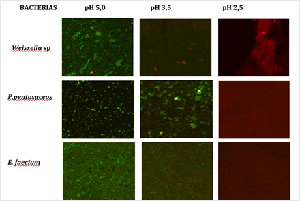Molecular characterization and determination of the probiotic character of lactic acid bacteria isolated from the gastrointestinal microbiome of the growing chicken
DOI:
https://doi.org/10.51252/revza.v2i2.395Keywords:
16S rRNA, lactic acid bacteria, microbiota, chickenAbstract
The gastrointestinal microbiota of the chicken is a fundamental component of poultry production in physiological, zootechnical and veterinary terms. Worldwide, studies related to the chicken microbiota are presented as a main priority of the poultry sector with research focused on probiotic and / or pathogenic microorganisms. In the frame-work of the present work, the isolation was achieved in Man Rogose and Sharpe medium of 32 strains of lactic acid bacteria from the gastrointestinal microbiota. The partial sequencing of the 16S rRNA al-lowed the molecular identification of these three lactic acid bacterial strains from the ventricle (Weissella sp.), from the cecum (Pediococcus pentosaceos and Enterococcus faecium). To determine their probiotic nature, these bacterial strains were evaluated based on acid resistance tests (pH 2.5, 3.5 and 5), bile (0, 0.10, 0.15 and 0.30%) and in vitro antagonism against Salmonella typhimurium. The results contribute to the availability of new probiotic strains for the poultry production sector and to the modernization of the technologies for characterization and molecular identification of the microorganisms of the chicken microbiota.
Downloads
References
Ararsa, B., & Solomon, D. (2019). Review on the effect of probiotics in poultry production industry. Research, Academic Research Journal of Agricultural Science And, 7(6), 312–318. https://doi.org/10.14662/ARJASR2019.029
Baurhoo, B., Ferket, P. R., & Zhao, X. (2009). Effects of diets containing different concentrations of mannanoligosaccharide or antibiotics on growth performance, intestinal development, cecal and litter microbial populations, and carcass parameters of broilers. Poultry Science, 88(11), 2262–2272. https://doi.org/10.3382/ps.2008-00562
De Man, J. C., Rogosa, M., & Sharpe, M. E. (1960). A medium for the cultivation of lactobacilli. Journal of Applied Bacteriology, 23, 130–135. https://doi.org/10.1111/j.1365-2672.1960.tb00188.x
Eckburg, P. b., Bik, E. m., Bernstein, C. n., Purdom, E., Dethlefsen, L., Sargent, M., Gill, S. r., Nelson, K. e., & Relman, D. a. (2005). Diversity of the Human Intestinal Microbial Flora. Science, 308(5728), 1635–1638. https://doi.org/10.1126/science.1110591
Eckert, N. H., Lee, J. T., Hyatt, D., Stevens, S. M., Anderson, S., Anderson, P. N., Beltran, R., Schatzmayr, G., Mohnl, M., & Caldwell, D. J. (2010). Influence of probiotic administration by feed or water on growth parameters of broilers reared on medicated and nonmedicated diets. Journal of Applied Poultry Research, 19(1), 59–67. https://doi.org/10.3382/japr.2009-00084
Fayol-Messaoudi, Domitille Berger, Cédric N Coconnier-Polter, M.-H., Liévin-Le Moal, V., & L Servin, A. (2005). PH-, Lactic acid-, and non-lactic acid-dependent activities of probiotic Lactobacilli against Salmonella enterica Serovar Typhimurium. Applied and Environmental Microbiology, 71(10), 6008–6013. https://doi.org/10.1128/AEM.71.10.6008-6013.2005
Franz, C., Huch, M., Abriouel, H., Holzapfel, W., & Gálvez, A. (2011). Enterococci as probiotics and their implications in food safety. International Journal of Food Microbiology, 151(2). https://doi.org/10.1016/j.ijfoodmicro.2011.08.014
Gauthier, R. (2005). La Salud Intestinal: Clave de la Productividad - El Caso de los Ácidos Orgánicos (Jefo Nutrition Inc.). Avicultura. https://www.engormix.com/avicultura/foros/salud-intestinal-clave-productividad-t3528/

Published
How to Cite
Issue
Section
License
Copyright (c) 2022 Fredy Fabian-Dominguez, Miluska Vanessa Baylon-Cuba, Rosel Apaestegui-Livaque, Lourdes Vásquez-Rojas, Eric Mialhe

This work is licensed under a Creative Commons Attribution 4.0 International License.
The authors retain their rights:
a. The authors retain their trademark and patent rights, as well as any process or procedure described in the article.
b. The authors retain the right to share, copy, distribute, execute and publicly communicate the article published in the Revista de Veterinaria y Zootecnia Amazónica (REVZA) (for example, place it in an institutional repository or publish it in a book), with an acknowledgment of its initial publication in the REVZA.
c. Authors retain the right to make a subsequent publication of their work, to use the article or any part of it (for example: a compilation of their works, notes for conferences, thesis, or for a book), provided that they indicate the source of publication (authors of the work, journal, volume, number and date).






